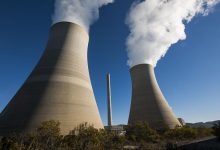The New South Wales Mount Piper black coal power plant will not be retired any earlier than 2040, EnergyAustralia’s new climate plan confirms, but the 1,400MW fossil generator will be relegated to “a reserve role” on the grid, potentially as soon as the early 2030s.
In its inaugural Climate Transition Action Plan (CTAP), published on Monday, EnergyAustralia sets out a basic plan to achieve net zero scope 1 and 2 emissions (they’ll get back to us on scope 3) by 2050, including through the development of up to 3GW of new renewables, to be committed or operational by 2030.
The renewables target – which EnergyAustralia says will focus on large-scale wind – is tiny in the context of the task ahead of the nation, given that the Australian Energy Market Operator says we need another 48GW of new wind and solar by 2030 to meet existing renewable energy targets.
See David Leitch’s analysis of the wind and solar efforts of Australia’s big three utilities: The decarbonisation efforts of Australia’s big gentailers are a disgrace
The 3GW number is also dwarfed by EnergyAustralia’s own announcement – also on Monday – that it will join a consortium of companies to build a 5GW offshore wind farm off the coast of Victoria’s Gippsland region.
But perhaps more disappointing is the unchanged closure date for Mt Piper, which EnergyAustralia in its 2021 climate plan brought forward by three years, from 2043 to 2040.
Despite a nod to the Paris Agreement “and the importance of the energy system’s contribution to limiting average global warming to well below 2°”, EnergyAustralia “reaffirms” the retirement date of its remaining coal plant as 2040.
And while this is well outside the timeline called for by climate scientists, there will interesting changes to how the coal plant will be run in its final years of operation.
As more renewables and energy storage come online, EnergyAustralia says Mount Piper will increasingly operate in a firming role for renewables, first by reducing output during periods of high renewables generation and then moving to a reserve or backup role – which the gen-tailer says it sees happening by the early to mid 2030s.
The report says the plant’s transition from baseload power to flexible operation – or for use “only when needed” – involves a series of initiatives which target short-duration flexibility as well as removing units from service for a longer duration.
For flexibility, EnergyAustralia says modification of each generation unit’s boilers and combustion configuration would allow the units, rated at peak capacity of 730MW (unit 1) and 700MW (unit 2), to generate safely at a very low load of 150MW, thereby burning minimal coal and producing fewer emissions.
“These low load modifications allow the asset to ramp down and quickly ramp up when generation from renewables is low,” the report says.
For longer duration generation services, a “wet layup” would allow the Mt Piper units to be turned off and stored with water in its boiler tubes, with a return to service within 36 hours when output is required.
“Such a role will not stand in the way of renewables firming coming into the system,” say EnergyAustralia chair Jane McAloon and managing director Mark Collette in a message at the beginning of the report.
“Rather, we see this role as bridging the technology gap until multi-day and seasonal storage is commercially available.”
See also: Closure deal on Australia’s dirtiest power station kills hopes of early 100pct renewables
EnergyAustralia says that while it thinks Mount Piper – as the newest coal plant on the NEM – is up to this battery-like task, appropriate market and policy settings will need to be in place to support the approach and “ensure its economic viability.”
“The implementation of such settings would reflect the obvious merits of the resulting lower emissions from Mount Piper and its anticipated contribution to energy system reliability,” the report says.









